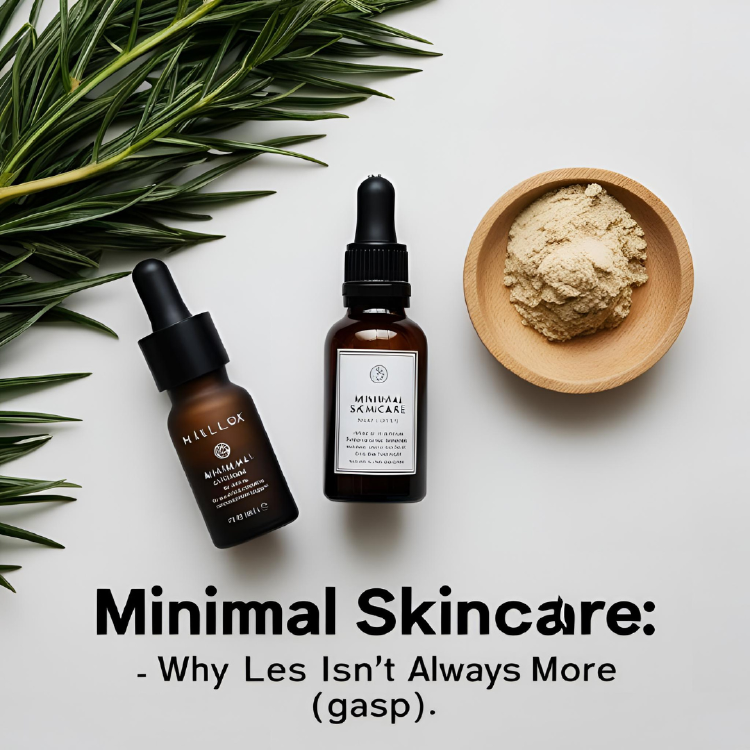Minimal Skincare: Why Less Isn't Always More (Gasp!)
Is a minimal skincare routine always better? Explore the pros and cons of minimalist vs. maximalist approaches to find what truly works for your skin.

- Seo Yuna
- 6 min read

Minimalist vs. Maximalist Skincare: Finding the Right Routine for You
In the ever-evolving world of skincare, two prominent philosophies often clash: minimalism and maximalism. The minimalist approach champions simplicity, advocating for a streamlined routine with only a few essential products. Conversely, maximalism embraces a more comprehensive regimen, incorporating a wider array of products and active ingredients. Which approach is truly better? The answer, as with many things related to skincare, is nuanced and depends on individual needs, skin type, and goals.
Understanding Minimalist Skincare
Minimalist skincare focuses on using only the products necessary to maintain healthy skin. This often translates to a routine consisting of:
- Cleanser: To remove dirt, oil, and makeup.
- Moisturizer: To hydrate and support the skin barrier.
- Sunscreen: To protect against harmful UV rays.
Pros of Minimalist Skincare:
- Reduced Risk of Irritation: Fewer products mean a lower chance of encountering ingredients that could irritate or cause allergic reactions. This is particularly beneficial for those with sensitive skin.
- Cost-Effective: A minimalist routine typically involves fewer and often less expensive products, making it a budget-friendly option.
- Simplified Routine: A shorter routine saves time and effort, making it easier to maintain consistency.
- Reduced Waste: Using fewer products contributes to less packaging waste, aligning with environmentally conscious values.
Cons of Minimalist Skincare:
- May Not Address Specific Concerns: A basic routine might not be sufficient to target specific skin issues like acne, hyperpigmentation, or advanced signs of aging.
- Slower Results: Without targeted active ingredients, improvements in certain skin concerns may be slower or less noticeable.
Diving into Maximalist Skincare
Maximalist skincare involves a more elaborate routine with multiple steps and a wider range of products, often incorporating active ingredients to address specific concerns. A maximalist routine might include:
- Double Cleansing: Using an oil-based cleanser followed by a water-based cleanser.
- Toner: To balance skin’s pH.
- Serums: Targeting specific concerns like hydration, brightening, or anti-aging (e.g., Vitamin C, hyaluronic acid, retinol).
- Moisturizer: To hydrate and support the skin barrier.
- Facial Oil: To lock in moisture.
- Sunscreen: To protect against harmful UV rays.
- Masks: Used weekly or bi-weekly for targeted treatments.
Pros of Maximalist Skincare:
- Targeted Treatment: Allows for the use of specific active ingredients to address a variety of skin concerns simultaneously.
- Potentially Faster Results: The inclusion of potent ingredients can lead to quicker and more visible improvements.
- Customizable: A multi-step routine can be tailored to individual needs and preferences, adjusting products based on skin’s changing conditions.
Cons of Maximalist Skincare:
- Increased Risk of Irritation: Using multiple active ingredients can increase the likelihood of irritation, sensitivity, and even damage to the skin barrier. Over-exfoliation and combining incompatible ingredients are common pitfalls.
- Can Be Expensive: A comprehensive routine can be costly, requiring a significant investment in multiple products.
- Time-Consuming: A lengthy routine demands more time and effort, which can be difficult to maintain consistently.
- Potential for Overconsumption: The allure of new products and trends can lead to unnecessary purchases and product waste.
The Skin Barrier: A Key Consideration
Regardless of whether you lean towards minimalism or maximalism, maintaining a healthy skin barrier is paramount. The skin barrier, or stratum corneum, is the outermost layer of the skin, responsible for protecting against environmental aggressors and preventing moisture loss [^1]. A compromised skin barrier can lead to:
- Increased sensitivity
- Redness and inflammation
- Dryness and dehydration
- Acne breakouts
- Eczema flare-ups
How to Protect Your Skin Barrier:
- Gentle Cleansing: Avoid harsh soaps and cleansers that strip the skin of its natural oils.
- Hydration: Use a moisturizer containing humectants (like hyaluronic acid), emollients (like ceramides), and occlusives (like shea butter) to hydrate and seal in moisture [^2].
- Avoid Over-Exfoliation: Limit the use of chemical exfoliants (AHAs, BHAs) and physical scrubs to prevent irritation.
- Sun Protection: Sunscreen is crucial for protecting the skin barrier from UV damage.
- Incorporate Barrier Repair Ingredients: Look for products containing ingredients like ceramides, niacinamide, and fatty acids, which help to strengthen and repair the skin barrier [^3].
Active Ingredients: Use with Caution
Active ingredients are ingredients with proven benefits for the skin, such as:
- Retinoids: For anti-aging and acne treatment.
- Vitamin C: For brightening and antioxidant protection.
- AHAs/BHAs: For exfoliation and improving skin texture.
- Niacinamide: For reducing inflammation and improving skin tone.
While active ingredients can be highly effective, they also have the potential to cause irritation if used incorrectly. Here are some guidelines for incorporating active ingredients into your routine:
- Start Slowly: Introduce one new active ingredient at a time, allowing your skin to adjust before adding another.
- Use Low Concentrations: Begin with lower concentrations and gradually increase as tolerated.
- Alternate Days: Use active ingredients on alternate days to minimize irritation.
- Avoid Combining Irritating Ingredients: Be cautious when combining ingredients like retinoids and AHAs/BHAs, as they can increase sensitivity.
- Listen to Your Skin: Pay attention to how your skin reacts and adjust your routine accordingly. If you experience redness, dryness, or irritation, reduce the frequency or concentration of the active ingredient.
Skin Cycling: A Balanced Approach
Skin cycling is a strategic approach that involves cycling through different active ingredients with periods of rest to allow the skin to recover. A typical skin cycling routine might involve:
- Night 1: Exfoliation: Use an AHA/BHA exfoliant to remove dead skin cells and improve texture.
- Night 2: Retinoid: Apply a retinoid to promote collagen production and address signs of aging or acne.
- Night 3 & 4: Recovery: Focus on hydration and barrier repair with gentle, nourishing products.
Skin cycling can be a helpful way to incorporate active ingredients without overwhelming the skin, reducing the risk of irritation and maximizing benefits [^4].
Tailoring Your Routine to Your Skin Type
- Dry Skin: Focus on hydration with humectants, emollients, and occlusives. Gentle cleansing and avoiding harsh exfoliants are crucial.
- Oily Skin: Opt for lightweight, non-comedogenic products. Incorporate BHAs to control oil production and prevent breakouts.
- Combination Skin: Balance hydration and oil control. Use targeted treatments for specific areas of concern.
- Sensitive Skin: Prioritize gentle, fragrance-free products. Avoid harsh active ingredients and focus on barrier repair.
- Acne-Prone Skin: Use targeted treatments like salicylic acid and benzoyl peroxide. Avoid pore-clogging ingredients and maintain a consistent routine.
Expert Opinions
Dermatologists often recommend a balanced approach, emphasizing the importance of a core routine consisting of cleansing, moisturizing, and sun protection. They also advise incorporating active ingredients strategically, based on individual skin concerns and tolerance levels. It’s generally recommended to consult with a dermatologist or skincare professional to determine the best approach for your specific needs.
Debunking Skincare Myths
- Myth: More products equal better results.
- Fact: Overloading the skin with too many products can lead to irritation and counteract the benefits.
- Myth: Natural ingredients are always better.
- Fact: Natural ingredients can be beneficial, but they are not necessarily safer or more effective than synthetic ingredients. Some natural ingredients can be irritating or allergenic.
- Myth: You need to exfoliate every day.
- Fact: Over-exfoliating can damage the skin barrier. Exfoliate 1-3 times per week, depending on your skin type and tolerance.
- Myth: Expensive products are always better.
- Fact: Price does not always equate to quality or effectiveness. Many affordable products contain effective ingredients.
Conclusion
Ultimately, the choice between minimalist and maximalist skincare is a personal one. There’s no one-size-fits-all answer, and the best approach is the one that works best for your individual skin. Whether you prefer a streamlined routine with a few essential products or a comprehensive regimen with multiple active ingredients, the key is to listen to your skin, prioritize its health, and make informed choices based on your specific needs and goals. Remember to introduce new products gradually, protect your skin barrier, and consult with a skincare professional for personalized advice.
Unlock Your Healthiest Skin – Backed by Science and Personalization
Cosmi is your personal AI cosmetologist — offering tailored skincare recommendations and expert advice based on your unique skin type, concerns, and goals.
Visit Cosmi